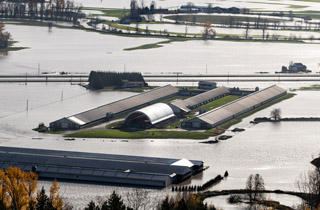BC_flooded_farm

The Canadian Press photo by Darryl Dyck
A farm in Abbotsford, B.C., is surrounded by floodwaters in this photo taken on Nov. 17.
As floodwaters that have engulfed portions of British Columbia, Canada, this week begin to recede, the province is compiling a list of area veterinarians with food animal, equine and/or emergency response experience to aid in the devastation's grim aftermath by providing care for thousands of animals, including euthanasia when necessary.
Those registered to practice in the province could be called upon directly by producers or producer groups in coming weeks to help animals in need. The College of Veterinarians of British Columbia warned its members to approach volunteering with caution.
"It would be prudent for veterinarians to confirm their insurance coverage for any harm they may incur themselves or that they may cause to others arising from the provision of veterinary services in these challenging circumstances," the organization said in an email alert.
The Canadian Veterinary Response, a volunteer system within the Canadian Veterinary Medical Association, is ready but has yet to be activated by the provincial Ministries of Agriculture, Food and Fisheries, Chief Executive Officer Jost am Rhyn confirmed this morning.
Thousands of cattle, horses and other animals are believed to be in distress or deceased in and around Abbotsford, a city near the U.S. border that's been inundated with flooding driven by torrential rain and overflowing waterways. The region, called Sumas Prairie and known for its fertile land, was home to Sumas Lake before it was artificially drained during the early 1920s.
The crisis gripping the Sumas Prairie, in eastern Abbotsford, now centers on supplies. With roads and bridges washed away or closed, shortages of food, gasoline and medical supplies are on the horizon. According to reports, residents in multiple towns have been trapped for days. Bottled water is almost nonexistent.
Meanwhile, thousands of farm animals are either standing in near-freezing water or have drowned in recent days, creating new and future problems for the area's agriculture sector, and spurring environmental concerns in the process.
At least three veterinary practices closed in the region. Agwest Veterinary Group in Abbotsford is one of the practices that is open, but only for emergencies. A women who answered the phone provided a quick synopsis of what's happening at the practice before ending the call.
"It's still a triage situation here, so it might be a couple of days before we get our heads above water," she said hurriedly. "We're still in rescue mode."
Locals report that many barns remain underwater, and smaller livestock such as pigs and chickens have drowned. Their carcasses and flooded manure pits are contaminating the landscape.
That's creating a problem for the cattle, which have been standing in contaminated water for days, drinking it by the gallons. The area produces 50% of the province's milk. Experts predict that many of the cattle will get mastitis, dry up and then have to be euthanized.
On a message board of the Veterinary Information Network, an online community of the profession and parent of the VIN News Service, Dr. Josephine Banyard in nearby Chilliwack described what she and her husband, also a veterinarian, are seeing in the region.
"A bunch of young guys are saving cattle (by boat) and many farmers are trucking cattle to other farms — huge neighborly kindness abounding — so nice," she wrote.
By phone, Banyard described the situation as "surreal."
"There's a lot of people who are coming to us because they can't get to their regular vet," she said. "But they seem so preoccupied. People are just in a panic to get food and supplies. They're just trying to survive."
Correction: This article has been changed to correct a reference to the hydrogeology of the flooded region and elaborate on its history.